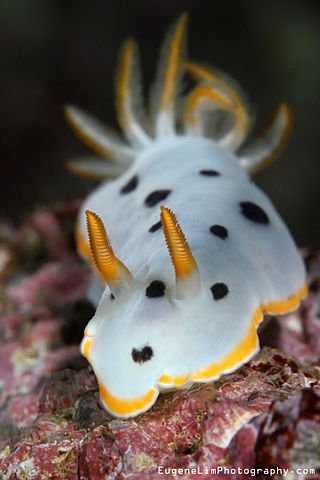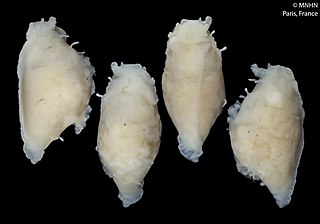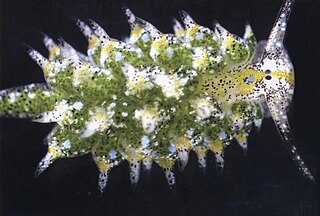
The California sea hare is a species of sea slug in the sea hare family, Aplysiidae. It is found in the Pacific Ocean, off the coast of California in the United States and northwestern Mexico.

Elysia chlorotica is a small-to-medium-sized species of green sea slug, a marine opisthobranch gastropod mollusc. This sea slug superficially resembles a nudibranch, yet it does not belong to that clade. Instead it is a member of the clade Sacoglossa, the sap-sucking sea slugs. Some members of this group use chloroplasts from the algae they eat for photosynthesis, a phenomenon known as kleptoplasty. Elysia chlorotica is one species of such "solar-powered sea slugs". It lives in a subcellular endosymbiotic relationship with chloroplasts of the marine heterokont alga Vaucheria litorea.

Limapontiidae is a taxonomic family of small to minute sacoglossan sea slugs. These are marine opisthobranch gastropod mollusks.

Nembrotha lineolata is a species of nudibranch, a sea slug, a marine gastropod mollusk in the family Polyceridae. It is found in shallow water in the Indo-Pacific. It was first described in 1905 by the Danish malacologist Rudolph Bergh. The type locality is Selayar Island, Indonesia.

Elysia timida is a species of sacoglossan sea slug, a marine opisthobranch gastropod mollusk. Found in the Mediterranean and nearby parts of the Atlantic, it is herbivorous, feeding on various algae in shallow water.

Elysia pusilla is a species of small sea slug, a marine gastropod mollusk in the family Plakobranchidae. It is a sacoglossan.
Murphydoris is a genus of sea slugs, specifically dorid nudibranchs, marine gastropod molluscs in the family Goniodorididae.

Chromodoris orientalis is a species of colourful sea slug, a dorid nudibranch, a marine gastropod mollusc in the family Chromodorididae. Sea slugs are generally very beautifully colored organisms with intense patterns and ranging in sizes. The Chromodoris orientalis specifically is a white sea slug with black spots in no particular pattern with a yellow, orange, or brown in color ring around its whole body and on its gills. There is much discussion on where it is found, what it eats, how it defends itself without a shell, and its reproduction methods. This is all sought after information because there is not much known about these animals.

Bosellia mimetica is a species of sea slug, a marine gastropod mollusk in the family Plakobranchidae. It is a very small sea slug growing to less than 1 centimetre (0.4 in) in length. It has a rounded, flattened body and is a mottled green, a colour that mimics that of the algae Halimeda tuna and Flabellia petiolata on which it lives and feeds. Its range includes the Mediterranean Sea, the Iberian peninsula, the Caribbean Sea and the Atlantic coast of South America. The type locality is the island of Capri, in Italy.

Costasiella kuroshimae—also known as a "leaf slug", or "leaf sheep"—is a species of sacoglossan sea slug. Costasiella kuroshimae are shell-less marine opisthobranch gastropod mollusks in the family Costasiellidae. Despite being animals they indirectly perform photosynthesis, via kleptoplasty.
Oxynoe antillarum is a species of small sea snail or sea slug, a bubble snail, a marine gastropod mollusk in the family Oxynoidae.
Aiteng ater is a species of sea slug, a marine gastropod mollusc in the family Aitengidae. The specific name ater is from the Latin language and means black, in reference to the appearance of the slug on the mud.
Phyllodesmium pecten is a species of sea slug, an aeolid nudibranch, a marine gastropod mollusc in the family Facelinidae.

Elysia diomedea is a species of sea slug, a marine gastropod mollusc in the family Plakobranchidae.

Okenia zoobotryon is a species of sea slug, a dorid nudibranch, a marine gastropod mollusc in the family Goniodorididae. It is normally found on the colonial bryozoan Amathia verticillata on which it lives and feeds.

Onchidoris proxima is a species of sea slug, a dorid nudibranch, a shell-less marine gastropod mollusc in the family Onchidorididae. This species is found in the northeastern and northwestern parts of the Atlantic Ocean. It is also reported from the northeastern Pacific Ocean. Previously in the genus Adalaria this species was moved to Onchidoris as a result of a molecular phylogeny study.

Costasiella ocellifera is a small (5–13 mm) species of sea slug, a shell-less marine gastropod mollusk in the family Costasiellidae. Costasiella ocellifera, and other members of the Costasiellidae family are often mistakenly classified as nudibranchs because they superficially resemble other species of that group, but they are actually a part of the Sacoglossa superorder of sea slugs, also known as the “sap-sucking sea slugs,” "crawling leaves" or the "solar-powered sea slugs." C. ocellifera was discovered by Simroth in 1895, and was initially classified as Doto ocellifera. The Brazilian species, Costasiella liliana, is a synonym of C. ocellifera.Costasiella ocellifera shows long-term retention of functional kleptoplasty.
Janolus flavoanulatus is a sea slug species. The specific name is derived from Latin words flavus (“yellow”) and anulatus (“ringed”). These soft-bodied mollusks are known for their extraordinary colors and prominent forms. The first description of this species was reported by researcher Terry Gosliner, a leading researcher in the evolutionary history of nudibranchs. Upon his conducted research in the Philippines, Gosliner named Janolus flavoanulatus for its yellow ring around its cerata.

Thuridilla vataae is a species of sacoglossan sea slug, a shell-less marine opisthobranch gastropod mollusc in the family Plakobranchidae. It is native to the tropical Indo-Pacific. It was first described by the French zoologist Jean Risbec in 1928; its specific name refers to the Bay of Anse Vata, just south of Nouméa, New Caledonia, where the type specimen was collected.

Costasiella nonatoi is a species of sacoglossan sea slug in the genus Costasiella. It is one of few species in the genus that is not photosynthetic. The description of this species was based on two specimens which were serially sectioned and designated as the holotype. The species was named after Dr. Edmundo Nonato, a professor at the Oceanographic Institute of the University of São Paulo.














